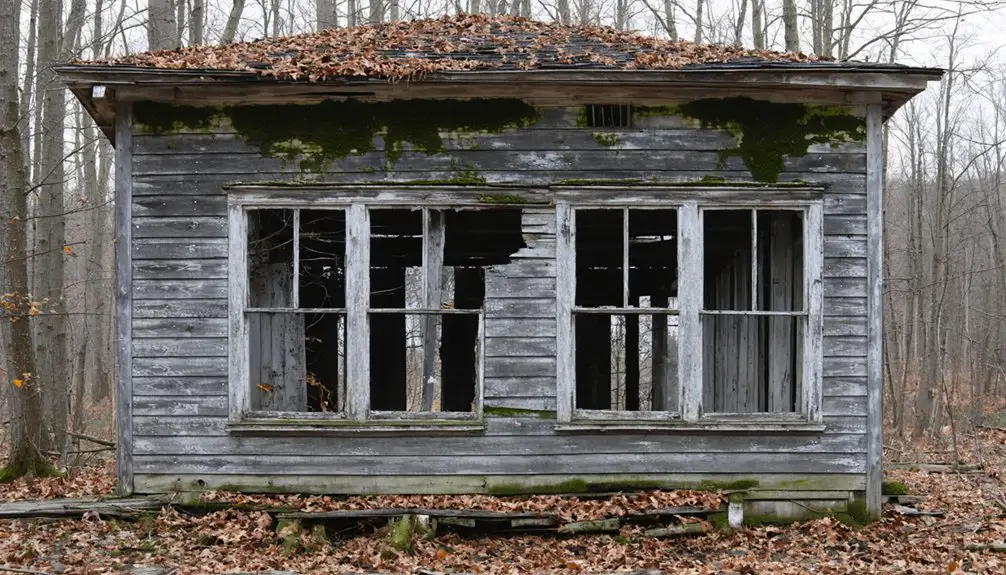You’ll find Foxtown at coordinates 40.48417°N, 78.92222°W in Western Pennsylvania’s coal country, accessible via the 46-mile Ghost Town Trail. This former mining community thrived in the late 1800s, featuring company-built housing and rich immigrant cultural traditions. Today, you can explore weathered building foundations, a preserved cemetery, and remnants of coal mining operations. The town’s connection to the Ghost Town Trail offers a window into Pennsylvania’s industrial heritage.
Key Takeaways
- Foxtown was a thriving Pennsylvania mining town located at 40.48417°N, 78.92222°W, now accessible via the 46-mile Ghost Town Trail.
- The town flourished during Fayette County’s mining boom, attracting diverse immigrant groups who worked in nearby coal mines.
- Stone foundations, weathered mining buildings, and a preserved cemetery remain as physical remnants of Foxtown’s coal mining heritage.
- Visitors can access Foxtown through former railroad corridors and U.S. Route 422, with multiple trailhead parking options nearby.
- Safety concerns include deteriorating structures and uneven terrain, requiring visitors to stay on designated paths during daylight hours.
The Rise of Pennsylvania’s Coal Mining Towns
As Pennsylvania’s coal mining industry emerged in the late 1700s, it sparked the creation of numerous mining towns across the state’s diverse geography.
These settlements experienced dramatic economic growth, particularly after railroads like the Huntingdon and Broad Top Mountain line connected mining regions in the early-mid 1800s.
You’ll find the earliest operations at Coal Hill near Pittsburgh, where bituminous mining began, and Sharp Mountain in Carbon County, where anthracite was discovered in 1791. The room-and-pillar method became the standard approach for underground mining operations throughout these early settlements.
By 1830, Pittsburgh alone consumed over 400 tons of coal daily. The community culture in these towns was shaped by waves of immigrants – first Welsh, English, and Scottish miners, then Eastern and Southern Europeans. Colonel Isaac Meason made history when he constructed the first rolling mill west of the Alleghenies in 1816.
As mining employment surged from 3,000 workers in 1840 to 39,000 by 1865, these towns became vibrant centers of industrial activity.
Mapping Foxtown’s Location and Surroundings
You’ll find Foxtown located at 40.48417°N, 78.92222°W in Western Pennsylvania’s coal country, situated near the winding Ghost Town Trail that connects Black Lick to Ebensburg.
The town’s position along former railroad corridors provides access via both the recreational trail system and nearby U.S. Route 422, which serves as a main transportation artery through the region. The trail was established in 1991 through a significant land donation from Kovalchick Salvage Company.
Key landmarks surrounding Foxtown include Blacklick Creek, which threads through the valley, and neighboring ghost towns like Vintondale that share its mining heritage.
Geographic Proximity to Centralia
Located in Columbia County’s coal region, Foxtown shares the same geographic corridor as the infamous ghost town of Centralia. While the exact distance between these abandoned communities isn’t well-documented, you’ll find both settlements nestled within Pennsylvania’s eastern coal fields, connected by a network of state routes and Interstate 81.
The Foxtown history and Centralia connection are evident in their shared landscape features – abandoned mine infrastructure, overgrown streets, and reclaimed natural areas typical of Appalachian ghost towns. The area contains sidewalks and curbs that hint at the once-thriving communities that existed here. With a population density of 134.47 people per square mile in Columbia County, the region showcases the dramatic transformation from bustling mining towns to sparsely inhabited areas.
You’ll encounter similar terrain characteristics around both locations, including wooded areas, minor roads, and old cemeteries. The towns are part of a broader network of mining communities, accessible via Routes 901, 54, 61, and 42, which serve as primary arteries through this historically rich coal region.
Key Landmarks and Boundaries
When exploring Foxtown’s landscape today, you’ll find a rich tapestry of natural and historical landmarks that define this abandoned mining settlement.
The community boundaries stretch across the intersection of Indiana and Cambria counties, where the Ghost Town Trail preserves the landmark significance of Pennsylvania’s coal mining heritage. The trail’s 46-mile length winds through the historic terrain, connecting multiple abandoned mining communities. Visitors can spot various wildlife including deer and bears along the forested paths. You’ll discover remnants of industrial activity alongside thriving wildlife habitats, with the Blacklick Creek watershed providing a natural corridor through the region.
- Historic coal tipples, iron furnaces, and railroad artifacts mark the industrial past
- Multiple trailheads from Saylor Park to Ebensburg offer strategic access points
- The western slope of the Allegheny Front creates dramatic elevation changes and diverse terrain
These features combine to create a distinct boundary between active communities and abandoned mining sites, preserving Foxtown’s historical footprint.
Regional Access Routes
Traversing to Foxtown’s historic grounds requires understanding the intricate network of routes that connect this abandoned mining settlement to Western Pennsylvania’s major thoroughfares.
You’ll find the Ghost Town Trail serving as your primary access point, stretching 46-49 miles between Black Lick and Ebensburg. For trail accessibility, use PA Route 403 near Dilltown or U.S. Route 22‘s intersection.
Regional connectivity expands through multiple entry points, including Saylor Park in Blairsville and the Ebensburg trailhead. You can access the area through neighboring towns like Wehrum, Vintondale, and Nanty Glo, each offering parking facilities. Seasonal restrooms are available at various access points along the trail. The trail meanders past beautiful mountain streams and diverse wildflower species throughout its length.
The trail’s crushed limestone surface includes the main 32-mile stem and a 17-mile C&I Extension, with the Rexis Branch providing additional access via U.S. Route 422.
Life During the Mining Boom Years
During the peak of Fayette County’s mining boom, Foxtown transformed into a bustling hub of industrial activity as diverse waves of immigrants and workers flocked to the region.
You’d find a rich tapestry of cultural traditions from Irish, Italian, Slavic, and Middle Eastern communities living in company-built mining patches. The constant operation of nearby iron furnaces required workers to maintain round-the-clock shifts to keep production flowing.
Despite labor tensions and economic hardships, these diverse groups forged strong community bonds centered around social halls, schools, and local gatherings.
- Your daily life revolved around the mining schedule, with wages paid in company script redeemable only at company stores.
- You’d live in a company town complete with housing, schools, and essential facilities for your family.
- As part of the community, you’d experience a unique blend of ethnic customs, languages, and religious practices that shaped social life.
Underground Fires and Environmental Hazards
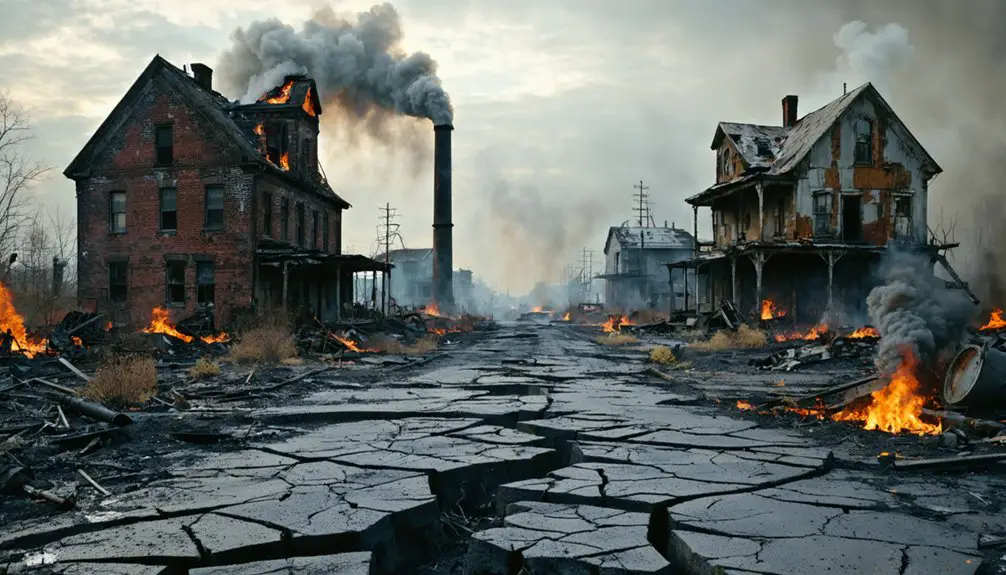
Although underground fires posed minimal risks during Foxtown’s early mining days, a catastrophic incident in 1962 changed everything when a garbage dump fire spread into abandoned coal mines beneath the town.
You’ll find that the slow-burning anthracite coal created persistent underground hazards that could last over 250 years. The fire’s toxic emissions released lethal carbon monoxide levels while creating dangerous sinkholes and unstable ground conditions.
Early fire mitigation efforts failed due to bureaucratic restrictions and funding limitations. The government eventually allocated $42 million to relocate residents after recognizing the severity of the environmental threat.
The fire’s impact extended beyond safety concerns, altering soil chemistry, disrupting groundwater flows, and changing local vegetation patterns due to the intense underground heat.
The Exodus: Why Residents Left
While the underground fires posed an immediate threat, multiple factors converged to drive residents from Foxtown in the late 20th century. Despite their historical significance and strong community resilience, families faced mounting pressures that made staying impossible.
You’d witness the economic devastation as coal mining operations ceased, leading to widespread unemployment and business closures. The government’s use of eminent domain in 1992, followed by discontinued relocation assistance in 2005, forced many to abandon their ancestral homes.
- Toxic gases and ground instability created severe health and safety risks, with sinkholes threatening buildings and infrastructure.
- Social bonds fractured as families split between those who left and those who stayed, destroying generations of community ties.
- The permanent nature of the environmental damage, projected to last 250+ years, eliminated any hope of return.
Remnants of a Lost Community
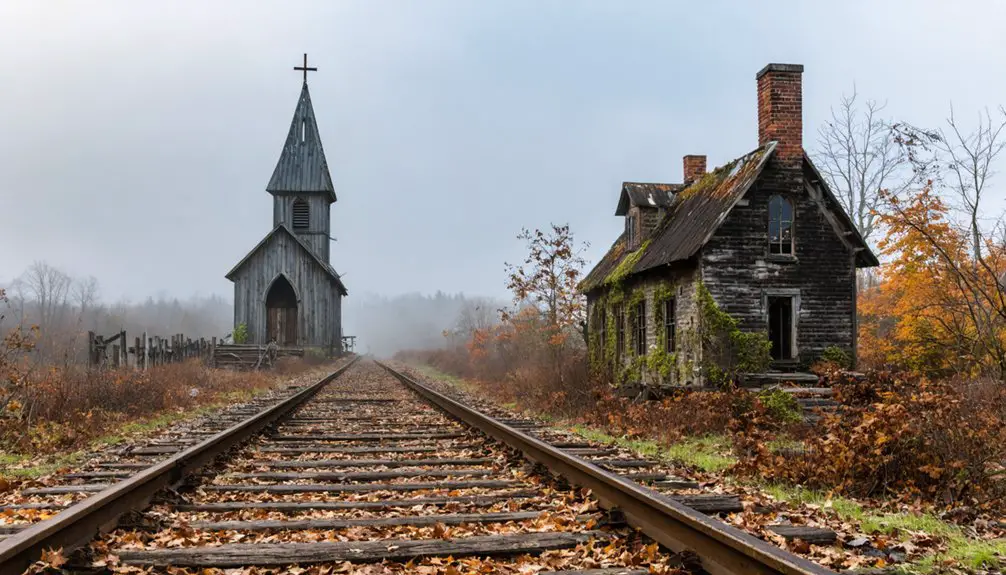
Among Foxtown’s crumbling remnants, you’ll find the weathered shells of coal mining buildings that once powered the local economy.
The stone foundations of the town’s church still mark what was once a spiritual center for the community.
At the outskirts of this abandoned settlement, a well-preserved cemetery stands as the final tribute to generations of residents who called Foxtown home.
Crumbling Coal Mining Buildings
Crumbling remnants of Foxtown’s coal mining buildings stand as silent witnesses to Pennsylvania’s industrial past.
You’ll find thick-walled structures built with local materials, showcasing the practical coal mining architecture that once housed generations of miners and their families. These company-built doubles and row houses tell stories of community resilience, when workers lived under the watchful eye of their employers.
- Deteriorating boiler houses and lamp houses reveal the industrial backbone of mining operations
- Abandoned company stores and blacksmith shops hint at the self-contained nature of these coal patches
- Foundational ruins and fragmentary iron fixtures mark where mining tipples once processed coal
Today, these decaying structures serve as powerful reminders of the region’s peak coal production era, which reached 277 million tons in 1917.
Preserved Stone Church Foundations
Sacred stones mark the enduring legacy of Foxtown’s historic church, with foundations dating back to 1743. You’ll find these remarkable remnants of historical architecture near natural springs that once supplied the town’s grist mills. The roughly-cut stones, sourced locally, reveal authentic 18th-century Pennsylvania construction methods.
While preservation challenges include seasonal freeze-thaw cycles and invasive plant growth, these foundations tell a vital story of colonial-era settlement. You can still trace the church’s original perimeter and observe unique water management features in the stonework.
The site’s orientation aligns with nearby cemeteries, offering glimpses into the community’s careful planning. Though some walls have partially collapsed, local historians work to protect these sacred ruins through vegetation control and structural stabilization efforts.
Cemetery Still Stands Today
Perched atop a hillside overlooking the former town site, Foxtown’s cemetery stands as one of the last physical remnants of this vanished coal mining community.
You’ll find weathered but readable headstones that tell the stories of the families who once called this place home. The cemetery’s symbolism extends beyond mere burial grounds – it serves as a gathering point where descendants still connect with their roots, especially during Memorial Day observances.
- Active plots are still being sold, showing the cemetery’s enduring role in community remembrance
- Local historical societies help maintain the grounds, preserving this essential link to Pennsylvania’s coal mining heritage
- Grave inscriptions provide valuable genealogical data for researchers studying the region’s past
Preservation Efforts and Historical Documentation
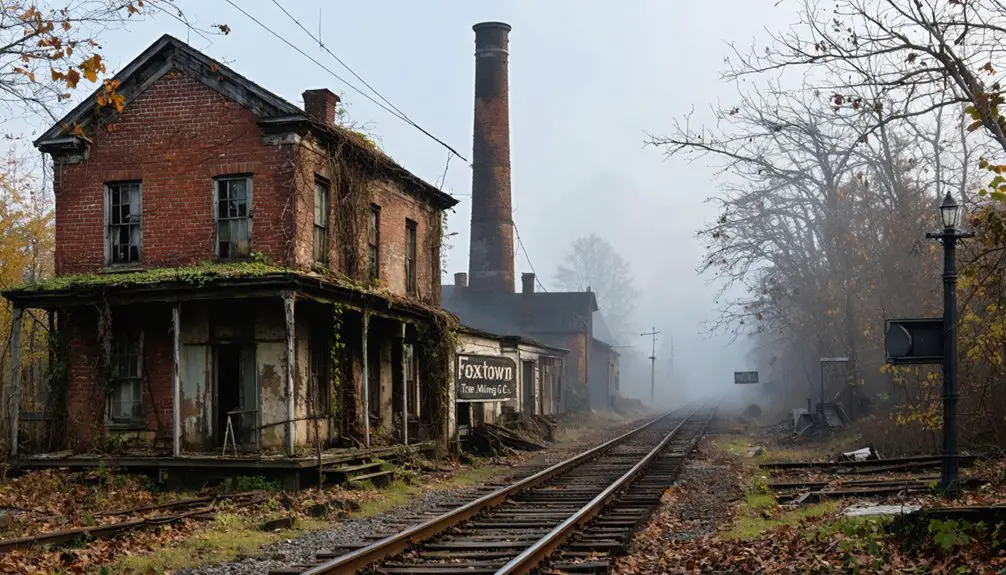
Various preservation initiatives safeguard the memory of Foxtown and similar Pennsylvania ghost towns through strategic documentation and site maintenance.
You’ll find these historical narratives preserved through both government programs and local historical societies, which actively document and protect these abandoned communities. The National Park Service’s designation of the Ghost Town Trail highlights the federal commitment to preserving Pennsylvania’s mining heritage, while state agencies manage site access and safety.
You can explore extensive documentation of the region’s ghost towns through scholarly works like “Delano’s Domain” and numerous digital archives.
Local historical organizations partner to maintain interpretive exhibits, historical markers, and educational programs that keep these communities’ stories alive for future generations.
Natural Reclamation of Abandoned Structures
As nature steadily reclaims Foxtown’s abandoned structures, a complex ecological transformation unfolds across the ghost town’s landscape. You’ll witness native plants colonizing the ruins, with roots penetrating foundations and mosses blanketing old stonework.
Through ecological succession, these buildings transform into natural habitats supporting diverse wildlife communities, from nesting birds to sheltering bats.
- Watch as vegetation gradually obscures building remains, blending them seamlessly into the surrounding forest.
- Observe wildlife creating new food webs as they inhabit the deteriorating structures.
- Experience the striking visual contrast between decaying human architecture and thriving natural growth.
The town’s evolution showcases nature’s resilience, as water patterns reestablish and soil enriches without human interference.
You’ll find the original settlement slowly dissolving into a wild ecosystem, where every crumbling wall becomes a foundation for new life.
Comparing Foxtown to Centralia’s Legacy
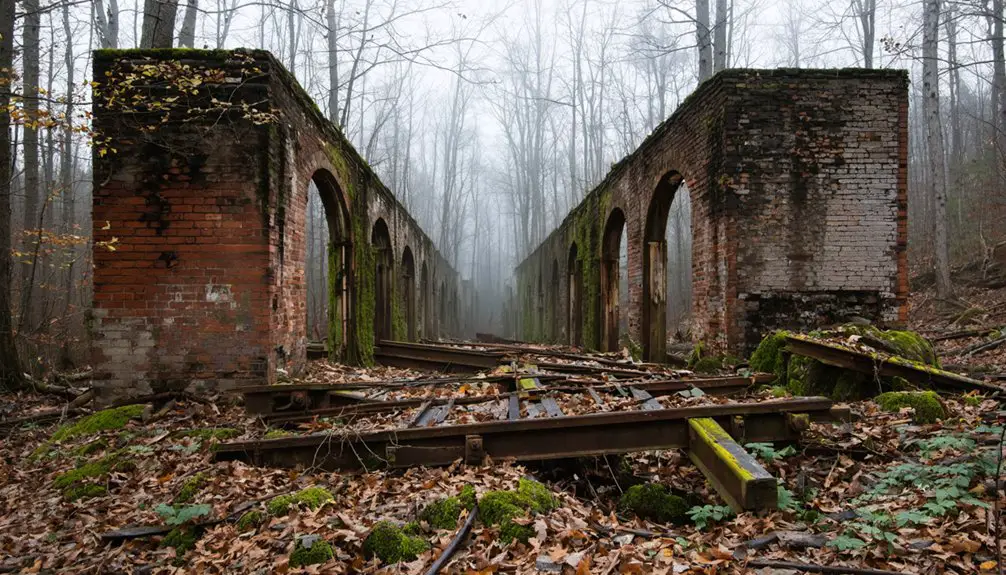
While both Foxtown and Centralia exemplify Pennsylvania’s ghost town legacy, their paths to abandonment tell starkly different stories – with Centralia’s devastating mine fire forcing rapid evacuation versus Foxtown’s gradual decline.
You’ll find that Centralia’s population dropped dramatically due to environmental hazards and government intervention, whereas Foxtown experienced a slower exodus typical of rural communities facing economic changes.
The environmental impact between the two sites also differs markedly, as Centralia continues to battle an underground inferno that will burn for centuries, while Foxtown’s structures simply weather natural deterioration.
Mining Legacy Parallels
Despite their distinct geographical locations, Foxtown and Centralia share remarkably similar mining legacies that shaped Pennsylvania’s industrial history.
You’ll find that both towns developed through underground coal mining, specifically utilizing room-and-pillar methods that defined the region’s mining heritage. Their economic dependency on coal extraction led to the establishment of company towns, complete with essential community infrastructure.
- Both towns contributed greatly to Pennsylvania’s industrial growth, supplying coal for iron and steel production in major cities like Johnstown and Pittsburgh.
- The mining operations left lasting environmental impacts, including waste material deposits, altered landscapes, and persistent groundwater issues.
- Economic decline followed similar patterns as coal seams depleted and technological changes reduced demand, leading to widespread job losses and community transformation.
Population Decline Similarities
The stark population decline patterns in Foxtown mirror those of Centralia, revealing how Pennsylvania’s ghost towns follow predictable demographic trajectories.
You’ll find these towns exemplify the state’s broader population trends, with over 40,000 residents leaving Pennsylvania between 2021-2022 alone.
Both communities share accelerating demographic shifts marked by aging populations and youth exodus.
Like Centralia before it, Foxtown’s working-age adults have steadily departed for economic opportunities elsewhere, particularly to lower-tax states like Florida and Texas.
This outmigration has created a challenging cycle: fewer young families mean lower birth rates and reduced community regeneration.
As the tax base erodes and senior populations grow, maintaining essential services becomes increasingly difficult, further fueling the town’s decline.
Environmental Impact Comparisons
Comparing environmental impacts between these Pennsylvania ghost towns reveals stark contrasts in their ecological legacies.
While you’ll find Centralia devastated by an underground coal fire that’s burned since 1962, Foxtown hasn’t suffered similar environmental catastrophes.
Centralia’s severe land stability issues and toxic gas emissions have created an uninhabitable wasteland that’ll persist for centuries.
- Centralia’s ongoing fire releases dangerous carbon monoxide and other toxic gases, causing serious environmental health concerns that forced resident evacuation.
- You’ll encounter treacherous sinkholes, ground subsidence, and steam vents throughout Centralia, while Foxtown maintains stable ground conditions.
- The government spent $42 million on Centralia’s environmental crisis, yet Foxtown never required such extensive intervention or remediation efforts.
These dramatic differences highlight how coal mine fires can permanently transform communities into hazardous zones.
Modern-Day Access and Safety Concerns
While Foxtown remains accessible year-round via the 36-mile Ghost Town Trail, visitors must navigate various safety challenges when exploring this abandoned mining settlement.
You’ll find clear signage and maintained pathways at multiple trailheads, including Black Lick, Dilltown, and Nanty Glo. However, trail safety demands your vigilance due to deteriorating infrastructure, unstable buildings, and uneven surfaces throughout the ghost town.
Despite well-marked trailheads and paths, visitors must remain alert for hazardous structures and rough terrain throughout the abandoned town site.
You’re advised to visit during daylight hours, as the remote location lacks lighting and emergency services are limited. Stay on designated paths to avoid hazardous structures and potential legal issues.
Weather can impact trail conditions considerably, so wear appropriate footwear and check conditions before your visit. While exploring, you’ll notice interpretive signs that help preserve the site’s mining heritage while keeping you informed of safety protocols.
Frequently Asked Questions
Are There Any Paranormal Activities Reported in Foxtown?
You’ll find documented ghost sightings and eerie sounds in the abandoned duplex, where investigators have encountered spirits of a young man and child, supported by discovered family photos and paranormal communications.
What Happened to the Personal Belongings Left Behind by Residents?
You’ll find abandoned items either decayed naturally, fell victim to vandalism, or were seized during government clearance. Some residents salvaged belongings, but many forgotten memories simply vanished as properties deteriorated over time.
Can Artifacts Found in Foxtown Legally Be Collected by Visitors?
Like a locked museum case, you can’t legally collect Foxtown artifacts. They’re protected by strict legal regulations and artifact preservation laws, requiring property owner permission and proper permits for any removal.
Were There Any Famous People or Notable Events in Foxtown?
You won’t find any famous residents specifically from Foxtown, though the area’s historical significance connects to Robert Morris, who owned nearby land, and the region’s devastating underground mine fire.
Do Any Former Foxtown Residents Hold Reunions or Maintain Contact?
Drawing a blank, you won’t find any documented reunions or contact networks among former Foxtown residents. While resident stories might exist within families, there’s no evidence of organized gatherings preserving Foxtown history.
References
- https://www.youtube.com/watch?v=Qj5LjacccJ0
- https://www.youtube.com/watch?v=8QDb8y9Nszs
- https://uncoveringpa.com/ghost-towns-in-pa
- https://en.wikipedia.org/wiki/Centralia
- https://www.youtube.com/watch?v=yxFuqGq-FJ8
- https://www.pa.gov/agencies/dep/programs-and-services/mining/bureau-of-mining-programs/pa-mining-history.html
- https://www.iup.edu/library/departments/archives/coal/coal-culture-timeline.html
- https://palaborhistorysociety.org/timeline-of-labor-history-in-pennsylvania/
- https://erieco.gov/2286/31921/Timeline-of-Eries-History
- https://philadelphiaencyclopedia.org/essays/coal/
